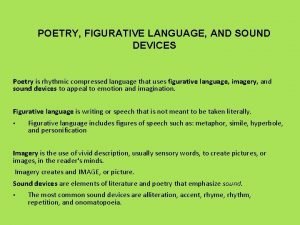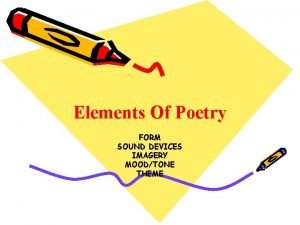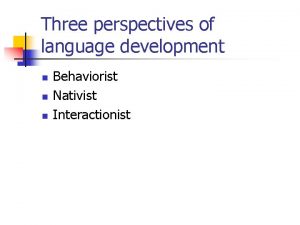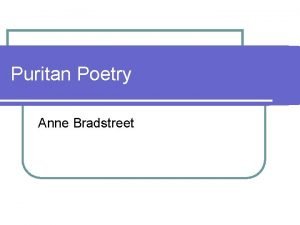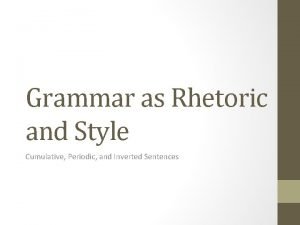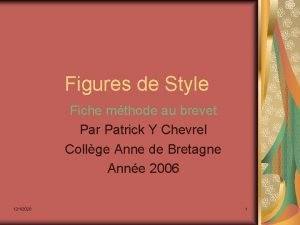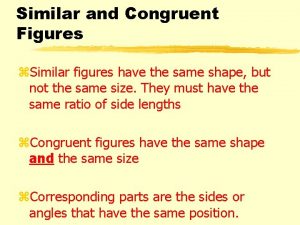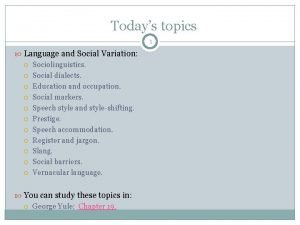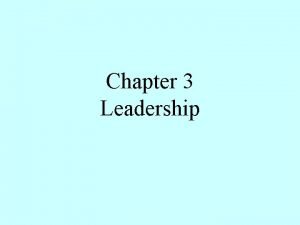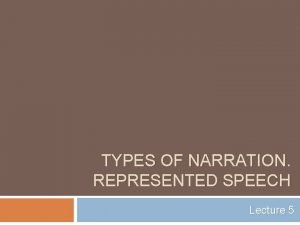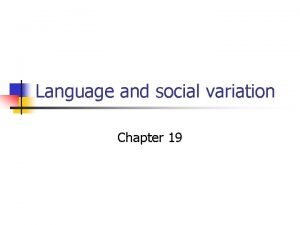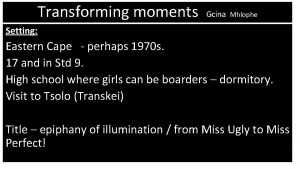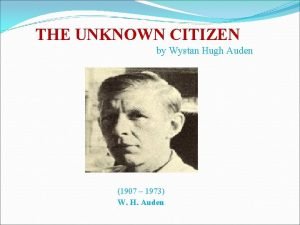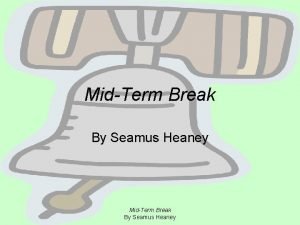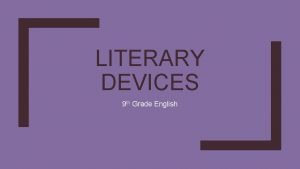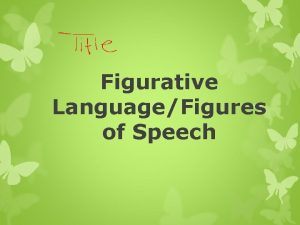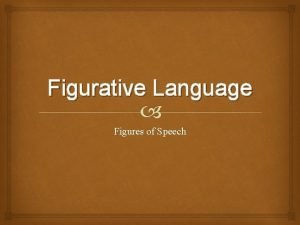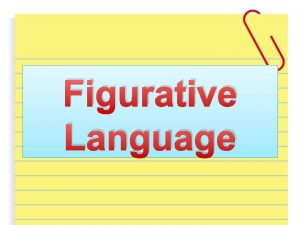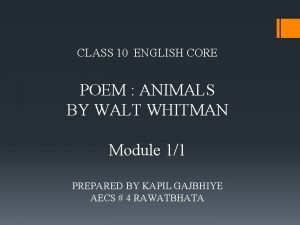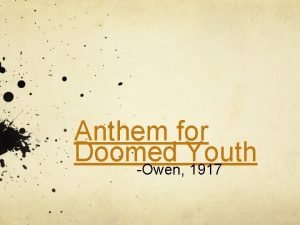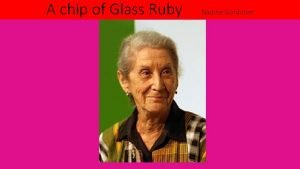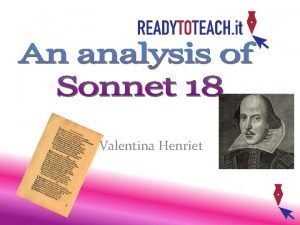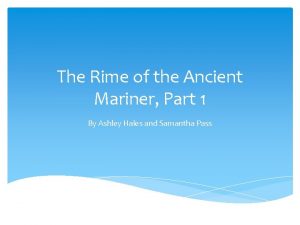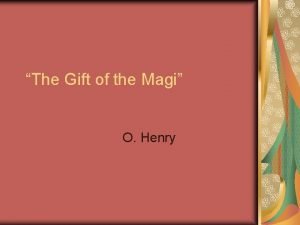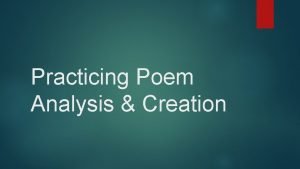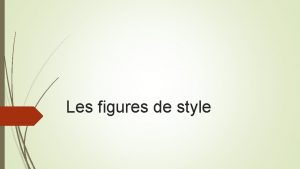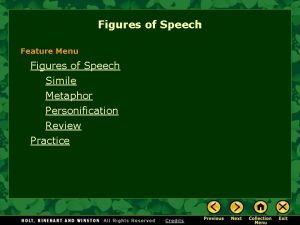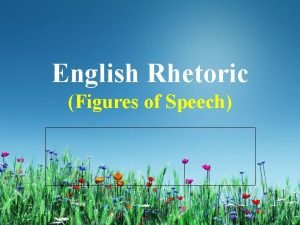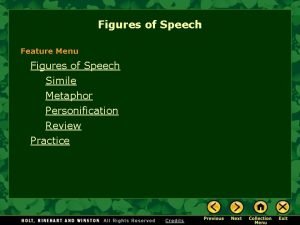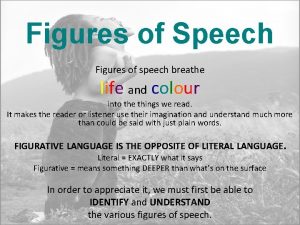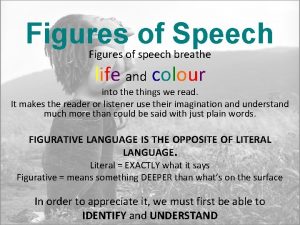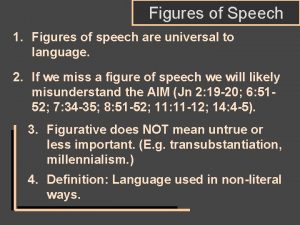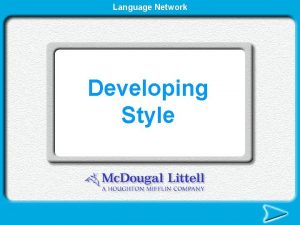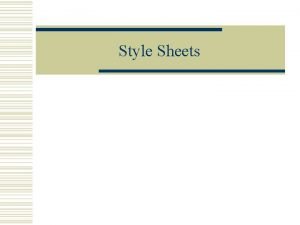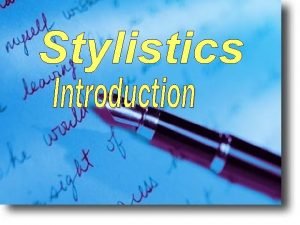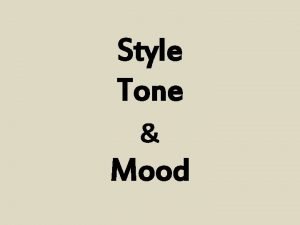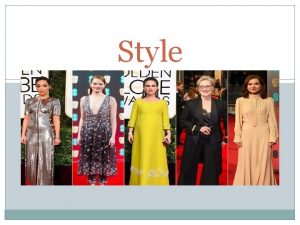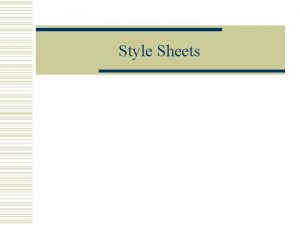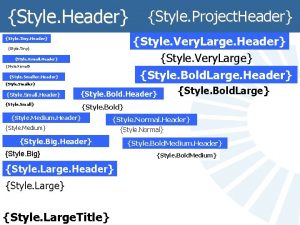Elements of Style Figures of Speech Figures of


































- Slides: 34

Elements of Style Figures of Speech

• Figures of speech are expressions that stretch words beyond their literal meanings. By connecting or juxtaposing (put together) different sounds and thoughts, figures of speech increase the breadth and subtlety of expression.

Alliteration • The repetition of similar sounds, usually consonants, at the beginning of word. • For example, “sweet, scented stuff. ”

Aposiopesis • A breaking-off of speech, usually because of rising emotion or excitement. • For example, “Touch me one more time, and I swear---”

Apostrophe • A direct address to an absent or dead person, or to an object, quality, or idea. • Walt Whitman’s poem “O Captain, My Captain, ” written upon the death of Abraham Lincoln, is an example of apostrophe.

Assonance • The repetition of similar vowel sounds in a sequence of nearby words. • For example, Tennyson creates assonance with the “o” sound in this line from “The Lotus-Eaters”: “All day the wind breathes low with mellower tone. ”

Cacophony • The clash of discordant or harsh sounds within a sentence or phrase. • Cacophony is a familiar feature of tongue twisters but can also be used to poetic effect, as in the words “anfractuous rocks” in T. S. Eliot’s “Sweeny Erect. ”

Chiasmus • Two phrases in which the syntax is the same but the placement of words is reversed, as in these line from Samuel Taylor Coleridge's “The Pains of Sleep”: “To be beloved is all I need, And whom I love, I loved indeed. ”

Cliché • An expression such as “turn over a new leaf” that has been used so frequently it has lost its expressive power.

Colloquialism • An informal expression or slang, especially in the context of formal writing, as in Larkin’s “Send No Money”: ”All the other lads there Were itching to have a bash. ”

Conceit • An elaborate parallel between two seemingly dissimilar objects or ideas

Epithet • An adjective or phrase that describes a prominent feature of a person or thing. • “Richard ‘the Lionheart’” and “’Shoeless’ Joe Jackson” are both examples of epithets.

Euphemism • The use of decorous language to express vulgar or unpleasant ideas, events, or actions. • For example, “passed away” instead of “died”; “ethnic cleansing” instead of “genocide. ”

Euphony • A pleasing arrangement of sounds. • Many consider “cellar door” one of the most euphonious phrases in English.

Hyperbole • An excessive overstatement or conscious exaggeration of fact: “I’ve told you about it a million times already. ”

Idiom • A common expression that has acquired a meaning that differs from its literal meaning, such as “it’s raining cats and dogs” or “a bolt from the blue. ”

Litotes • A form of understatement in which a statement is affirmed by negating its opposite: “He is not unfriendly. ”

Meiosis • Intentional understatement, as for example, in Shakespeare’s Romeo and Juliet, when Mercutio is mortally wounded and says it is only “a scratch. ” • Meiosis is the opposite of hyperbole and often employs litotes to ironic effect.

Metaphor • The comparison of one thing to another that does not use the terms “like” or “as. ” • Shakespeare is famous for his metaphors, as in Macbeth: “Life is but a walking shadow, a poor player That struts and frets his hour upon the stage. ”

Mixed Metaphor • A combination of metaphors that produces a confused or contradictory image, such as “The company’s collapse left mountains of debt in it wake. ”

Metonymy • The substitution of one term for another that generally is associated with it. • For example, “suits” instead of “businessmen. ”

Onomatopoeia • The use of words, such as “pop, ” “hiss, ” and “boing, ” that sound like thing they refer to.

Oxymoron • The association of two contrary terms, as in the expression “same difference, ” “government intelligence, ” or “wise fool. ”

Paradox • A statement that seems absurd or even contradictory on its face but often expresses a deeper truth. • For example, “The coach considered this a good loss. ”

Paralipsis • The technique of drawing attention to something by claiming not to mention it. • For example, from Melville’s Moby-Dick: “We will not speak of all Queequeg’s peculiarities her; how he eschewed coffee and hot rolls, and applied his undivided attention to beefsteaks, done rare. ”

Parallelism • The use of similar grammatical structures or word order in two sentences or phrases to suggest a comparison or contrast between them. • In Shakespeare’s Sonnet 129: “Before, a joy proposed, behind, a dream. ”

Pathetic Fallacy • The attribution of human feeling or motivation to a nonhuman object, especially an object found in nature. • For example, John Keat’s “ode to Melancholy” describes a “weeping” cloud.

Personification • The use of human characteristics to describe animals, things, or ideas. • Carl Sandburg’s poem “Chicago” describes the city as “Stormy, husky, brawling/City of the big Shoulders. ”

Pun • A play on words that exploits the similarity in sound between two words with distinctly different meanings. • For example, the title of Wilde’s play The Importance of Being Earnest is a pun on the word “earnest, which means serious or sober, and the name “Ernest, ” which figures into a scheme that some of the play’s main characters perpetrate.

Rhetorical Questions • A question that is asked not to elicit a response but to make an impact or call attention to something. • For example, the question “isn’t she great? ” expresses regard for another person and does not call for discussion.

Sarcasm • A simple form of verbal irony in which it is obvious from context and tone that the speaker means the opposite of what he or she says. • Sarcasm usually, but not always, expresses scorn. Saying, “That was graceful, ” when someone trips and falls is an example.

Simile • A comparison of two things through the use of “like” or “as. ” • The title of Robert Burn’s poem “My Love is Like a Red, Red Rose” is a simile.

Synocdoche • A form of metonymy in which a part of an entity is used to refer to the whole, for example, “my wheels” for “my car. ”

Trope • A category of figures of speech that extend the literal meanings of words by inviting a comparison to other words, things, or ideas. • Metaphor, metonymy, and simile are three common tropes.
 Poems with sound devices
Poems with sound devices Imagery elements of poetry
Imagery elements of poetry Block style letter with mixed punctuation
Block style letter with mixed punctuation Impersonal words examples
Impersonal words examples Informal writing styles
Informal writing styles Referential vs expressive style
Referential vs expressive style Inversion in a poem
Inversion in a poem Cumulative sentence
Cumulative sentence Figure de style brevet
Figure de style brevet Similar figures are congruent
Similar figures are congruent Plane shape
Plane shape What is the name of the solid figure
What is the name of the solid figure Overt prestige definition
Overt prestige definition Covert prestige definition
Covert prestige definition Speech on leadership styles
Speech on leadership styles Speech style
Speech style Social markers in sociolinguistics
Social markers in sociolinguistics Transforming moments summary
Transforming moments summary The unknown citizen poem
The unknown citizen poem What was the significance of the fur coat in the setting
What was the significance of the fur coat in the setting Two figures of speech that involve comparisons are?
Two figures of speech that involve comparisons are? What is onomatopoeia in figure of speech
What is onomatopoeia in figure of speech Figure of speech in my last duchess
Figure of speech in my last duchess Mid term break poetic techniques
Mid term break poetic techniques Extended metaphor definition
Extended metaphor definition Figurative speech personification
Figurative speech personification Antithesis figure of speech
Antithesis figure of speech Synecdoche examples sentences
Synecdoche examples sentences Figure of speech they do not lie awake in the dark
Figure of speech they do not lie awake in the dark Poetic devices in anthem for doomed youth
Poetic devices in anthem for doomed youth What is a chip of glass ruby
What is a chip of glass ruby Metaphor in sonnet 18
Metaphor in sonnet 18 Rime of the ancient mariner part 1
Rime of the ancient mariner part 1 The gift of magi foreshadowing
The gift of magi foreshadowing Farewell love by thomas wyatt summary
Farewell love by thomas wyatt summary
